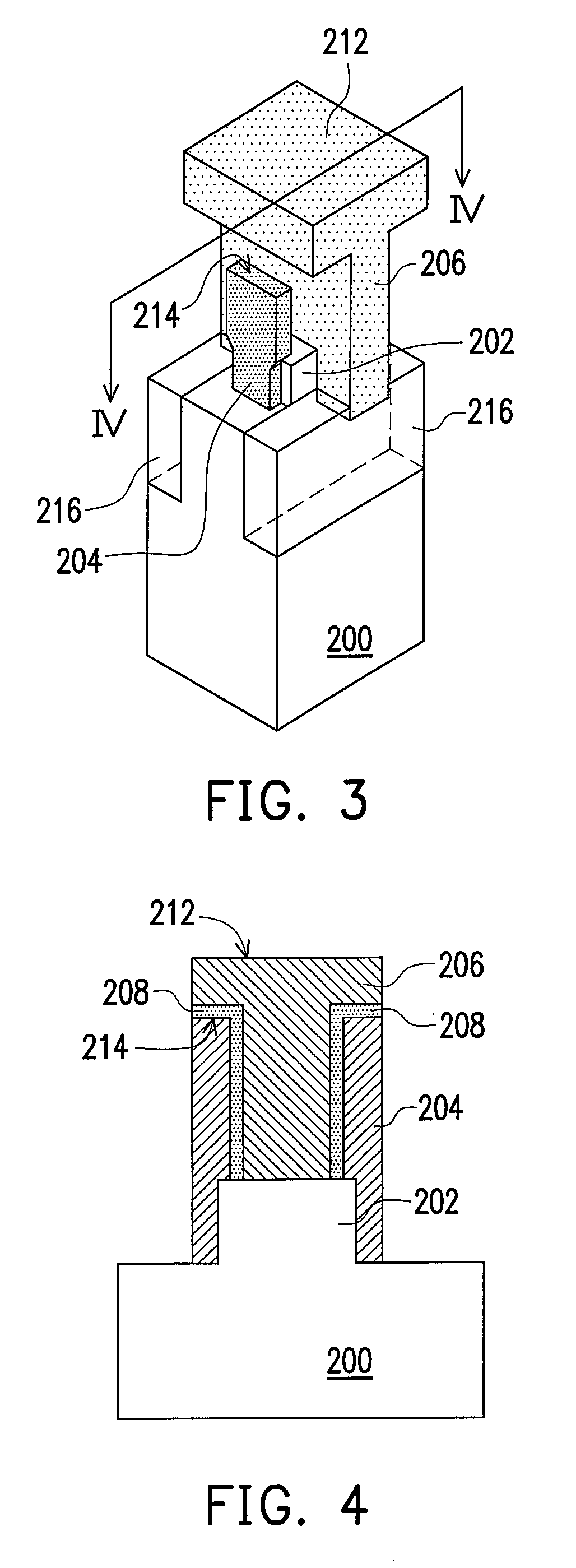Elevated channel flash device and manufacturing method thereof
a flash device and elevated channel technology, applied in the direction of semiconductor devices, electrical apparatus, transistors, etc., can solve the problems of low operation speed, reliability issues, narrow operation voltage range (or cell window) of memory cells, etc., and achieve the effect of increasing the effective floating gate length
- Summary
- Abstract
- Description
- Claims
- Application Information
AI Technical Summary
Benefits of technology
Problems solved by technology
Method used
Image
Examples
first embodiment
[0040]FIG. 1 is a perspective structural view of a FLASH device according to the present invention, in which some components are not shown for clarity. FIG. 2 is a cross-sectional view taken along line segment II-II in FIG. 1.
[0041]Referring to FIGS. 1 and 2, the FLASH device of the first embodiment includes a substrate 100 having a protrusion with a protrusive portion 102, two floating gates 104, a control gate 106, and a dielectric layer 108. The floating gates 104 are respectively disposed on two sides of the protrusive portion 102. A portion of a top surface 110 of the protrusive portion 102 is covered by the floating gates 104. The control gate 106 is disposed on top of the protrusive portion 102 and sandwiched between the floating gates 104. The dielectric layer 108 is disposed between each of the floating gates 104 and the control gate 106. In order to show the relative position of the control gate 106 and the floating gates104 clearly, the dielectric layer 108 is not shown i...
second embodiment
[0044]FIG. 3 is a perspective structural view of a FLASH device according to the present invention, in which some components are not shown. FIG. 4 is a cross-sectional view taken along line segment IV-IV in FIG. 3.
[0045]Referring to FIGS. 3 and 4, the FLASH device of the second embodiment includes a substrate 200 having a protrusive portion 202, two floating gates 204, a control gate 206, and a dielectric layer 208. The difference between the first and the second embodiments lies in the shape of the control gate 206. Here, the top surface of the control gate 206 laterally extends in two opposite directions to cover the top ends 214 top ends 214 of the two floating gates 204. Moreover, in order to show the relative position of the control gate 206 and the floating gates 204 clearly, the dielectric layer 208 is not shown in FIG. 3. In addition, FIG. 3 also includes isolation structures 216 and a protrusion formed on the substrate 200 and sandwiched between two of the isolation structu...
third embodiment
[0047]FIGS. 5A-5M are perspective views of the process to manufacture a FLASH device according to the present invention.
[0048]Referring to FIG. 5A, a substrate 500 is provided. The substrate 500 has a plurality of parallel isolation structures 502 such as STI structures.
[0049]Then, referring to FIG. 5B, a protrusive portion 504 is formed on the substrate 500 between two of the isolation structures 502. The method of forming the protrusive portion 504 is, for example, partially removing the substrate 500 between the isolation structures 502 as shown in this figure, or growing the protrusive portion on the substrate 500 by means of an epitaxy process.
[0050]Next, referring to FIG. 5C, a first conductive layer 506 is formed on the substrate 500 to cover the protrusive portion (not shown) and the isolation structures 502.
[0051]Then, referring to FIG. 5D, the first conductive layer above the isolation structures 502 (see 506 of FIG. 5C) is removed, so as to form a first strip of conductor...
PUM
 Login to View More
Login to View More Abstract
Description
Claims
Application Information
 Login to View More
Login to View More - R&D
- Intellectual Property
- Life Sciences
- Materials
- Tech Scout
- Unparalleled Data Quality
- Higher Quality Content
- 60% Fewer Hallucinations
Browse by: Latest US Patents, China's latest patents, Technical Efficacy Thesaurus, Application Domain, Technology Topic, Popular Technical Reports.
© 2025 PatSnap. All rights reserved.Legal|Privacy policy|Modern Slavery Act Transparency Statement|Sitemap|About US| Contact US: help@patsnap.com



